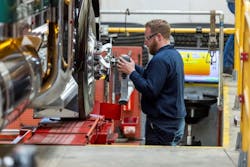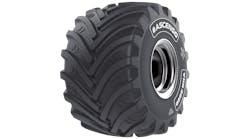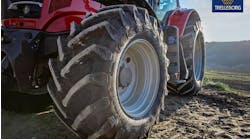From a profit opportunity standpoint, there’s more than meets the eye when it comes to truck alignment, says Kaleb Silver, director of product management, Hunter Engineering Co.
“Many times when you need to do an alignment there are what we traditionally call front end parts or suspension parts that need to be checked and occasionally replaced to ensure that alignment is going to hold.
“You have kingpins that wear. You have tie rods that wear, especially in vocational settings.”
Dump trucks, for example, often “see a higher wear rate than other vehicles,” he notes. “It’s not just about aligning the vehicle. It’s making sure all of the parts are good and you don’t have worn-out parts under the truck that are going to cause misalignment to reoccur quickly or will cause tire wear.
“A common misconception is that a front end alignment is all that really matters, but it’s not. You can have front tire wear that’s caused by tandem scrub.”
If tandems aren’t aligned properly, “they can basically ‘steer’ the truck as you’re driving and then you wear (out) the front tires trying to counter the rear push you’re getting.”
The problem also will cause ride complaints, according to Silver. Drivers will sometimes report “that the truck pulls one way or seems hard to control. These are common things that are the result of a misalignment on the rear of the vehicle.”
Alignment also can help reduce driver fatigue and increase safety, he says.
“Another thing is fuel economy. A lot of people think of wheel alignment as being a tire life-savings thing. It’s also about getting the best fuel economy possible. It takes a lot of fuel to wear tires down faster than they’re supposed to.”
“A lot of (truck owners) only think about aligning front tires because steer tires cost quite a bit. But you need to align all axles to get the best drive and the longest tire life.”
Tech training
“There are a lot of technicians who specialize in wheel alignment.” says Silver. “It can provide a great living.”
With the proper training, passenger car alignment technicians also can transition into performing truck alignments, he adds. “The adjustment is a little different comparing pickup trucks and cars to three-axle tractors and dump trucks and things like that, but the general concept is very much the same. You’re trying to align all the wheels to drive straight down the road.
“In our mind, it’s a great opportunity to take someone who’s showing promise in another position and give them a step up.”
Robust need
Hunter estimates that more than 50% of heavy trucks on roads today need an alignment.
“There’s a lot of opportunity and it’s opportunity that has a decent-size dollar figure attached to it,” says Silver.
“A three-axle truck alignment is commonly $300 or a little more in some markets. It can usually be completed within an hour or just a little bit more, depending on the shop and the technicians. It’s almost all labor.
“And it’s very likely during the course of performing an alignment that you’re going to identify other service items that are going to provide additional opportunity and additional income.”




